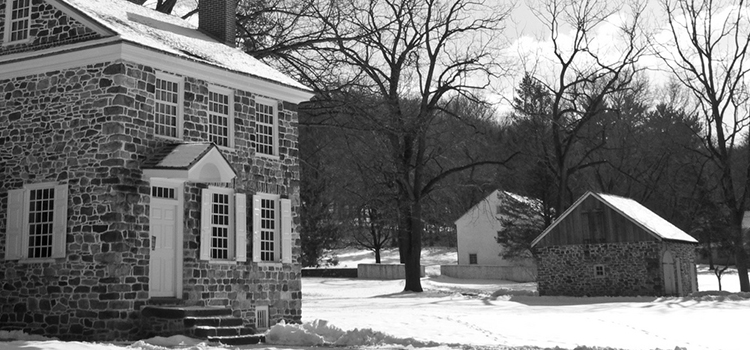What Archaeologists Know About George Washington's Time At Valley Forge

General Washington's headquarters in Valley Forge, PA.
Thomas via Flickr | http://bit.ly/1udlkyW
(Inside Science) -- Archaeologists, digging into George Washington’s headquarters at Valley Forge in Pennsylvania, have added domestic images to the picture of one of the most iconic moments of American history.
They may have found the cabin Washington had built so he could get out of the chaos of the headquarters, and perhaps eat in peace with his wife and officers.
It also turns out the Father of the Nation liked pork for dinner and may have instituted a no-smoking zone.
The work was done by archaeologists working with the National Park Service at the Valley Forge National Park, sometimes with volunteers from the public. The latest findings were reported earlier this month at a meeting of the Society for Historical Archaeology in Seattle by Joseph Blondino of the Fredericksburg, Virginia-based Dovetail Cultural Research Group.
Historian Wayne Bodle of Indiana University of Pennsylvania said Valley Forge “was unquestionably as important as it was iconic,” although it might not have been the turning point of the Revolutionary War; he doesn’t think there was a turning point.
It was, however, perhaps emblematic of the low point. The British had landed in Chesapeake Bay in August of 1777 and captured Philadelphia, the capital of the American colonies at the time. Washington’s Continental Army was defeated easily at Brandywine Creek and Germantown.
On Dec. 19, the army began a weeklong retreat to Valley Forge, located 20 miles north of Philadelphia.
It almost was a death march. The army was poorly clothed and largely unfed. Washington wrote you could tell their path by the blood from their bare feet in the snow.
“One half of our troops are without breeches, shoes and stockings,” Washington wrote, “and some thousands without blankets.”
At Valley Forge, Washington ordered them to build log “huts” of clay-daubed wood, even describing the size (14 by 16 feet), laid out in a street pattern, 12 men to a hut. The 2,000 huts gave some protection from the weather, but not much. The wind blew through the walls; the huts filled with smoke from badly designed stoves.
Nothing remains above ground of the huts, but archaeologists are still digging in the soil for artifacts.
Disease and frostbite were rampant at the encampment.
The quartermaster system broke down. They had no clothing, very little food, and had to send raiding parties through the area to keep from starving. Washington wrote to Congress that the men came near to mutiny.
Washington himself stayed in a tent until most of the men were housed. Then he moved into a small stone house (still standing), the Isaac Potts house, where he set up his headquarters.
“The rooms aren’t any larger than a normal house today,” Blondino said. It must have been chaotic.
Washington ordered a log cabin be built next to the Potts house so he could dine with his officers out of the bedlam of headquarters. His wife, Martha, spent most of the time with him and probably ate there as well, Blondino said. A letter she wrote was the only evidence of the cabin, but Blondino said a linear stain discovered by archaeologists covering a trench 25 feet in length, was probably part of the foundation.
Trash pits in the backyard nearby contained pig bones. Curiously missing was smoking pipe stems, Blondino said, usually ubiquitous in late 18th century digs. It might have been that Washington ordered the men not to smoke when they were at the noisy, crowded headquarters.
They were an undisciplined rabble more than an army. Enter a man known to history as Frederick William Augustus Henry Ferdinand, Baron von Steuben, a Prussian officer who knew no English and claimed--falsely--to be a Prussian general and nobleman, according to historian Christopher Ward's 1952 book "The War of the Revolution."
He was an organizational genius who pulled the quartermaster system together, brought discipline through the camp, and drilled the men how to be soldiers. By springtime, the men were a well-fed, well-dressed army.
In June, the British abandoned Philadelphia and Washington’s army, 11,000-12,000 strong, chased them across New Jersey. On June 28, 1778, the Americans took on what many believed to be the best army in the world at Monmouth Courthouse (now Freehold), and fought them to a standstill. The momentum never changed back.
The site is a good example of how a domestic landscape, scattered farms, can be turned into a military camp, Blondino said. Once the army left, archaeologists found, it quickly returned to its domestic functions.
Bodle said the army could have easily fallen apart and the revolution would have been over at Valley Forge. Washington and von Steuben kept it together to a stage where “more British strategic mistakes could lead to checkmate. Which finally happened.”

